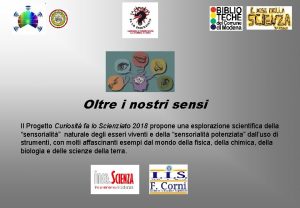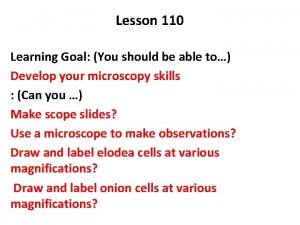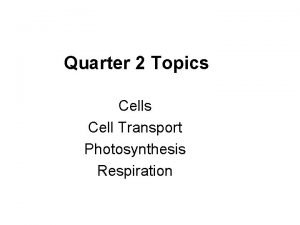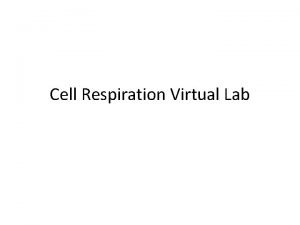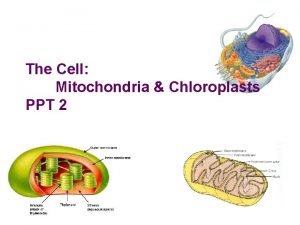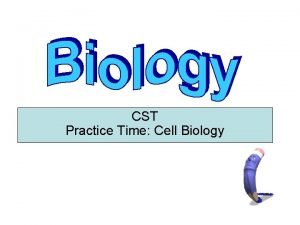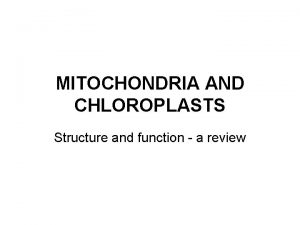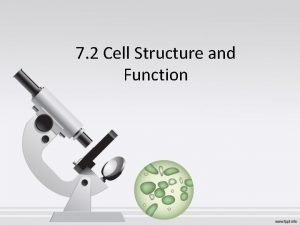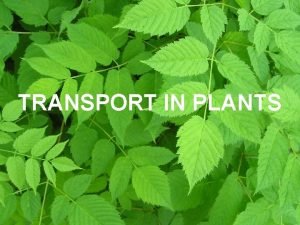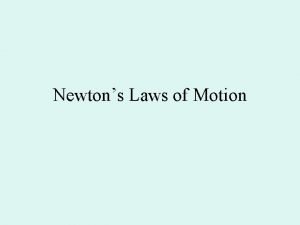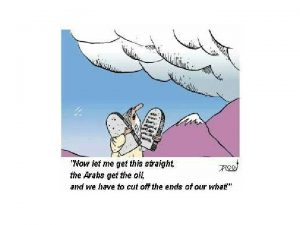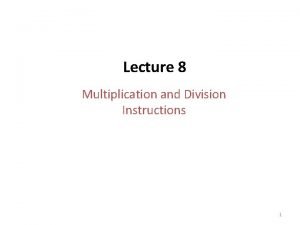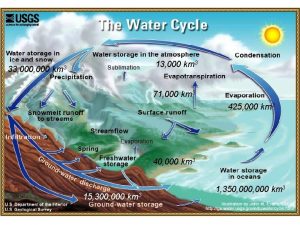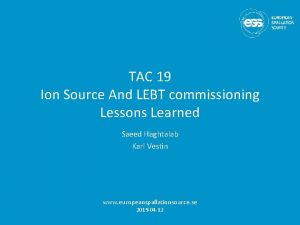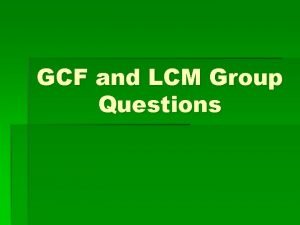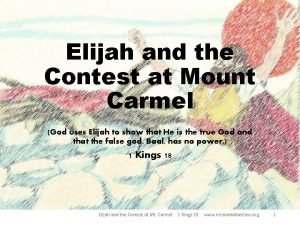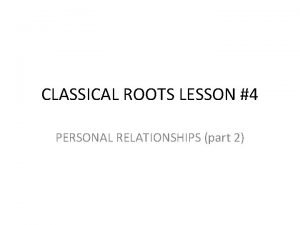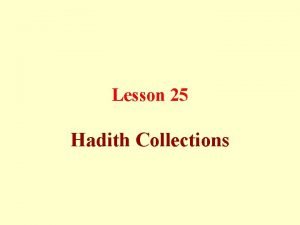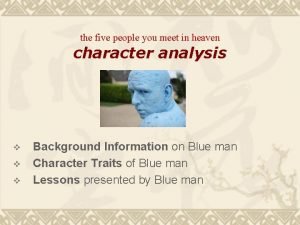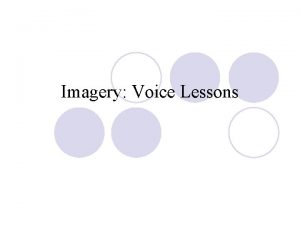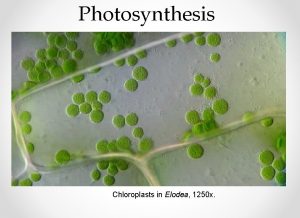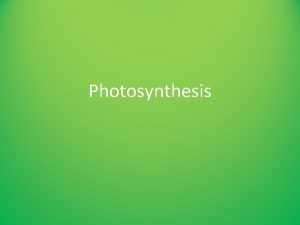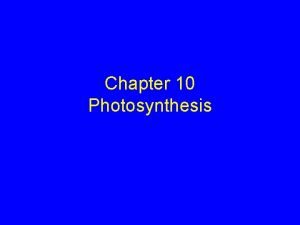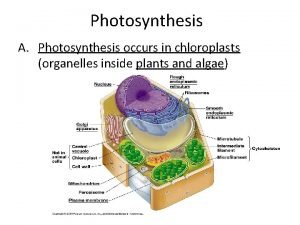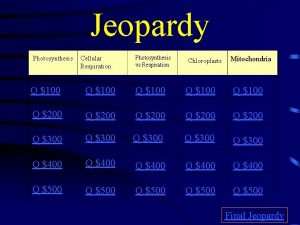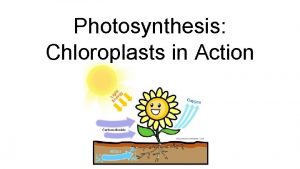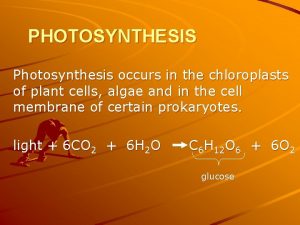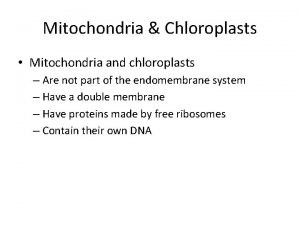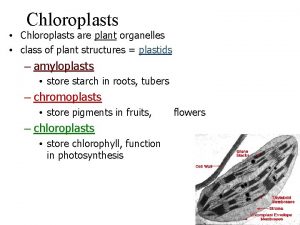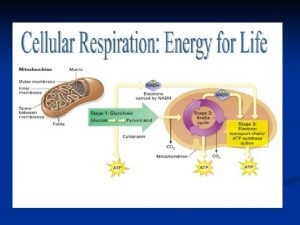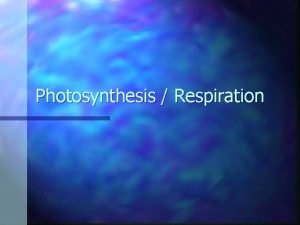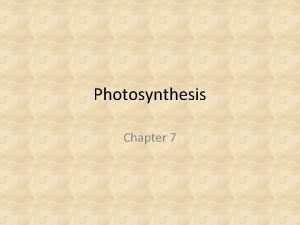Photosynthesis Chloroplasts in Elodea 1250 x Lessons From

































- Slides: 33

Photosynthesis Chloroplasts in Elodea, 1250 x.

Lessons From Thin Air • In 1995, filmmakers from the Harvard Smithsonian Center for Astrophysics approached some new graduates from Harvard and the Massachusetts Institute of Technology. • One of the questions they posed: “Here’s a seed. Imagine I planted that seed in the ground, and a tree grew. …Where did all that weight come from? ” “The President, ” a giant 3, 200 year-old sequoia in California with a height of 247 feet. 2

Autotrophs • Plants, algae, and some bacteria have the ability to use sunlight to generate their own storage molecules of energy. • They are photoautotrophs. – From the Greek photo- meaning “light, ” autos- meaning “self” and -troph meaning “nutrition. ”

• The basic knowledge that plants need water, sunlight, and soil has been around since ancient times. – The working hypothesis was that plants grew by “eating” soil through their roots. • Jean Baptiste von Helmont wanted to verify this – to isolate the exact source of the increased mass of trees as they grew. 4

The Willow Tree Experiment • Von Helmont planted a 5 pound willow tree in 200 pounds of dry, potted soil. • He massed the tree, grew it for 5 years, then massed it and the soil again. • The tree gained over 160 pounds of mass. – The soil only decreased in mass by about 2 ounces. 5

Matter • According to the law of conservation of mass, mass cannot be created nor destroyed. It only changes form. – Where then, does the dry mass of wood come from?

• Part of the mystery of how plants worked was due to a lack of understanding of air. • For many centuries, scientists believed that air was a pure, elementary substance. – This stemmed from the Greek philosopher Aristotle’s idea of all matter being composed of four elements: earth, fire, wind, and water.

Priestley’s Experiment • Joseph Priestley, a British chemist, believed that air was not a single “elementary substance”, but a “composition” of gases. • During one experiment, he discovered that a candle placed in a sealed jar would extinguish very quickly. – He called the air “injured, ” because it was unable to support fire. • Placing a mouse in the jar would have a similar effect, and it would die. – Priestley had discovered oxygen! 8

• Priestley’s hypothesis about the composition of air was correct. • Air is primarily made of: – – – 78% nitrogen 21% oxygen 0. 9% argon 0. 03% carbon dioxide 78% 21% 0. 02% water 9

Ingenhousz’s Experiment • A Dutch physician, Jan Ingenhousz, decided to repeat Priestley’s experiment, with a few changes. • Two sealed containers were studied – one exposed to sunlight, the other left in the shade. – The sunlit container showed an increase in oxygen compared to the shaded one. – Plants must be releasing oxygen! 10

Photosynthesis • The final piece of the puzzle was solved by a Swiss botanist named Nicolas de Saussure. – He enclosed the plants in a sealed container of carbon dioxide and compared the air and plant masses before and after growth. • Based on these measurements, he concluded that plants were primarily composed of: – Water from the soil. – Carbon from the air. • The process was called photosynthesis, because light (“photo”) was required to make (“synthesize”) the plant tissues. 11

• The concept of photosynthesis difficult to understand, because the idea of producing a heavy plant from air and water is not intuitive. – Converting the matter in air and water to plants requires a great deal of energy.

Energy • There are many different forms of energy in the universe. • Potential energy is stored energy. It exists as a result of position or chemical structure. Position. Chemical Structure. • Kinetic energy is in motion. 13

Electromagnetic Spectrum • Kinetic energy travels in the form of waves. Each type of energy has its own wavelength. 14

Energy and Life • Most of the energy that supports life on Earth originates from the sun. • Solar radiation primarily contains three ranges of wavelengths of energy: – Visible light, which we are able to detect with our eyes. – Ultraviolet, which has a shorter wavelength than visible light and is able to penetrate living tissue. – Infrared, or heat, which has a longer wavelength than visible light. 15

Photosynthesis • Plants have the ability to harness some wavelengths of visible light to convert matter in the air to that of their own tissues. • The primary location of photosynthesis is in leaves. – Cells within leaves have a high concentration of chloroplasts, each of which contains a green pigment called chlorophyll.

Endosymbiosis • The evolutionary origin of chloroplasts is believed to be similar to that of mitochondria. – Like mitochondria, chloroplasts have their own independently-replicating circle of DNA. • A eukaryotic cell (one that already had mitochondria) engulfed a prokaryote called cyanobacteria. – Cyanobacteria were the first photosynthetic cells, and still exist today.

• The complete chemical reaction of photosynthesis is summarized like this: • Carbon dioxide and water are used to synthesize glucose, which can then be used to produce starch or cellulose. – Oxygen is produced as a waste product.

Light Reactions • The first part of photosynthesis is called the lightdependent reactions, because they can only occur when sunlight is available.

• A photon of light strikes an arrangement of chlorophyll called photosystem II, causing the excitement of electrons and the splitting of water.

• The electron is passed to photosystem I, where it is re-energized by another photon and used to generate an electron carrier called NADPH. – The photosystems are unfortunately named based on the order they were discovered, not the actual order in photosynthesis.

• The chlorophyll found in photosystem II and I is referred to as P 680 and P 700, because it responds best to light at wavelengths of 680 and 700 nanometers (red).

• The H+ ions produced in the Photosystem II are used to generate ATP through an electron transport chain and chemiosmosis, similar to what happens during cell respiration.

Light Independent Reactions • The molecules of ATP and NADPH are then utilized by the light-independent reactions to generate glucose (C 6 H 12 O 6). • A source of carbon is required to generate this molecule, so the plant must breathe in carbon dioxide (CO 2) through tiny pores in its leaves called stomata.

• During the Calvin cycle, 6 molecules of carbon dioxide are used to synthesize 2 molecules of a 3 -carbon sugar called glyceraldehyde-3 phosphate or G 3 P. – The two molecules of G 3 P are joined to make glucose. • The energy within ATP and NADPH from the light reactions power the Calvin cycle.

• The enzyme that attaches the molecule of carbon dioxide to the 5 carbon molecule Ru. BP is called rubisco. – Rubisco is sometimes referred to as the “bridge” or “gateway” to life, because carbon dioxide is considered a lifeless molecule, but Ru. BP is organic and part of the plant’s cellular processes.

Color • Plants have multiple pigments in their leaves besides chlorophyll to help absorb the energy from visible light. • Collectively, these pigments are able to absorb most wavelengths of visible light.

• The only wavelengths that plants do not utilize are green. – Plants are green because that light is reflected.

Photorespiration • One of the biggest problems in plants is dehydration – water loss through the stomata of leaves. • On hot, dry days, plants close their stomata to conserve water. – This limits photosynthesis as CO 2 levels decline and O 2 levels build up. • This causes photorespiration, where O 2 is added to the Calvin cycle instead of CO 2. – Photorespiration is considered wasteful, because no ATP or sugar is produced by this process, while a lot of the carbon compounds in the plant are consumed.

Plant Adaptations • C 4 plants reduce this problem by moving the carbon fixation process to the mesophyll, a different layer of tissue closer to the surface of the leaf. – Since oxygen does not build up in the chloroplasts, photorespiration is avoided.

• CAM plants only open their stomata at night, when the air is cooler. – CO 2 is absorbed and stored, then released into the Calvin cycle gradually throughout the next day.

Products of Photosynthesis • The end result of the glucose produced by photosynthesis depends on the needs of the plant. • If a plant needs to grow, the glucose will be used to generate the polysaccharide cellulose. • Excess glucose can be stored as starch to be used at a later time. – Potatoes and other plants have specialized storage organelles called amyloplasts to produce and store starch.

• In addition to chloroplasts, plant cells also contain mitochondria and do perform cell respiration. – This allows them to process glucose into ATP when the plant cells are in need of chemical energy.
 Snail and elodea experiment
Snail and elodea experiment Elodea canadensis microscopio
Elodea canadensis microscopio Elodea cells
Elodea cells The bubbles released by elodea contain mostly
The bubbles released by elodea contain mostly Cell respiration virtual lab
Cell respiration virtual lab Ppt
Ppt A cell with chloroplasts is probably specialized for
A cell with chloroplasts is probably specialized for What is the function of the chloroplasts
What is the function of the chloroplasts Case study killing chloroplasts answers
Case study killing chloroplasts answers Rough endoplasmic reticulum function
Rough endoplasmic reticulum function Vascular tissue
Vascular tissue Which two protists contain chloroplasts
Which two protists contain chloroplasts First law of motion facts
First law of motion facts 1450-1250
1450-1250 How many sig figs in 1250
How many sig figs in 1250 1250 broadway prometric
1250 broadway prometric Một thùng hàng có 1250 cái cốc và chén
Một thùng hàng có 1250 cái cốc và chén Navsup 1250-1
Navsup 1250-1 Matrix ax 1250
Matrix ax 1250 19-10/1250
19-10/1250 Tac lessons learned
Tac lessons learned Lesson from naaman healing
Lesson from naaman healing You have diving lessons every fifth day
You have diving lessons every fifth day 6 lessons kung paano yumaman
6 lessons kung paano yumaman The contest at mount carmel summary
The contest at mount carmel summary Lessons 3 and 4 personal relationships
Lessons 3 and 4 personal relationships Prime lessons
Prime lessons Musnad collections of hadith
Musnad collections of hadith The five people you meet in heaven lessons
The five people you meet in heaven lessons Lessons from absalom life
Lessons from absalom life Mindup cost
Mindup cost Auditory imagery
Auditory imagery Prime lessons.org
Prime lessons.org Workday implementation lessons learned
Workday implementation lessons learned

